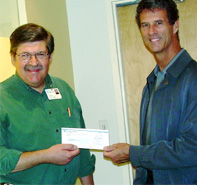
UCSF Medical Center recently received a rebate check from PG&E.
With energy and fuel costs rising across the country, UCSF is committed to incorporating environmentally-friendly and energy-efficient practices at campus facilities.
UCSF’s top energy-consuming buildings have been targeted for retrocommissioning – a reevaluation and resetting process for existing facilities to map out energy- and cost-saving strategies.
UCSF Medical Center recently received a nearly $30,000 rebate from Pacific Gas and Electric Company (PG&E) for installing a chiller compressor at the Mount Zion campus, as part of a University of California, California State University and Investor-Owned Utility (UC/CSU/IOU) Energy Efficiency Partnership sponsorship.
The new compressor – the mechanism that provides cooling for air conditioning systems – uses no oil, is nearly three times more energy-efficient than the old compressor and will reduce the state of California’s yearly energy usage by 212,610 kilowatt-hours. PG&E also contributed $621,000 to UCSF in May for a portfolio of energy-saving projects, and will add approximately $700,000 in additional funds once they are completed.
The UC/CSU/IOU Partnership provides a $0.24 per kilowatt-hour saved and $1.00 per therm saved incentive to support sustainable developments at UC, CSU and IOU facilities.
Other types of retrofitting – replacing old equipment with more efficient technology – are underway at UCSF. The Ambulatory Care Center (ACC) at the Parnassus campus is a focal point of energy-efficient research, including wind power, solar power and fuel cells, and a natural gas-powered electricity and heating system with near-zero greenhouse gas emissions. The ACC’s ventilation, air conditioning, boiler and lighting systems are being evaluated for future rebates and energy-saving rewards.
UCSF is in the process of evaluating the toll its facilities and operations have taken on the environment. In April, UCSF Chancellor Mike Bishop, MD, announced the formation of the Chancellor’s Advisory Committee on Sustainability (CACS) to examine UCSF’s effect on the environment, evaluate and propose policies and programs, and coordinate the actions of groups and individuals who are concerned about the environment.
Formation of the CACS demonstrates the University’s ongoing efforts and long-term commitment to reduce its impact on the environment while fulfilling its mission of advancing health worldwide™, as called for in the UCSF Strategic Plan. That plan, released in June 2007, specifically calls on the University to “develop environmentally sustainable approaches for controlling operating costs by reducing energy consumption, recycling and using alternative sources of energy, among other efforts.”
Strategic Energy Plan
The University of California also has been championing sustainable practices and policies. In March 2007, the UC Board of Regents adopted a Policy on Sustainable Practices to detail energy-saving plans for University campus facilities, transportation, operations, purchasing practices and waste management. The policy gave birth to the UC Strategic Energy Plan (SEP).
The five-tiered SEP, sponsored by the University of California Office of the President (UCOP), serves to identify, quantify, prioritize and assist UC campuses in identifying energy-saving opportunities in new construction and retrocommissioning, deferred maintenance, facility renewal and retrofit projects.
The SEP outlines projects to help the UCSF campus and medical center meet the Regents’ policy goals to revert greenhouse gas emissions and energy consumption by 2014 to the levels recorded in the year 2000, and by 2020 to the levels recorded in 1990.
Funded through the UC/CSU/IOU Partnership, the SEP brings together UCSF Capital Programs & Facilities Management and the medical center’s Office of Design & Construction for such energy-saving projects as:
• installing more efficient, motion-sensing light fixtures and vending machines;
• retrofitting heating, ventilation and air conditioning systems;
• monitoring systems for electricity, steam, natural gas, and hot and chilled water use;
• replacing old refrigerators and lab freezers with Energy Star units; and
• improving server, network and computer power management.
Set to commence in 2009 with a renewed UC/CSU/IOU Partnership, the SEP states that its primary goal is to “bring campus systems up to state-of-the-art technology.” The new projects target such construction standards as Leadership in Energy and Environmental Design (LEED), the benchmark sustainable building rating system from the US Green Building Council. A search for funding to supplement UC/CSU/IOU Partnership contributions is underway at UCOP.
With a focus on plans for electrical infrastructure and renewable energy, the projects are expected to produce savings equal in value to investment costs within the next 10 years.
At UCSF, the next big project targeted for LEED certification is the proposed medical center at Mission Bay. There, UCSF seeks to maximize and innovate sustainable and eco-effective design and operations within the project funding available and in accordance with the UC Policy on Sustainable Practices.
Design, construction, operations and purchasing strategies for the new UCSF Medical Center at Mission Bay will integrate the best green practices available and incorporate leading-edge discoveries from evidence-based design: a body of knowledge which demonstrates that the built environment can positively affect healing, health, safety and well-being.

